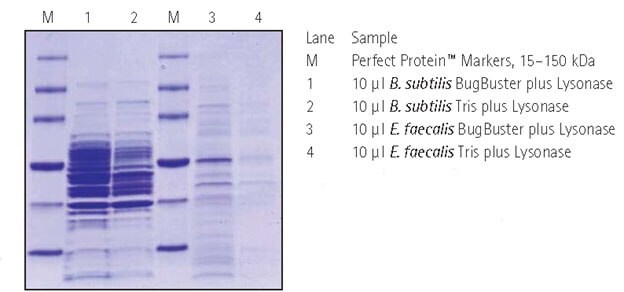Use of BugBuster® and Lysonase™ Reagents for efficient protein extraction from Gram-positive bacteria
BugBuster® Protein Extraction Reagent has become a valuable tool for extraction of proteins from E. coli without the need for mechanical disruption. It is also known that supplementing BugBuster® (as well as its derivative, PopCulture™ Reagent) with a small amount of lysozyme enhances the efficiency of extraction from E. coli, especially for larger proteins1. Furthermore, the addition of Benzonase® Nuclease to the extraction mixture degrades the liberated nucleic acids, reducing viscosity and potential interference of DNA and/or RNA with purification procedures2. With this issue of inNovations, we introduce Lysonase™ Bioprocessing Reagent, which is an optimized blend of rLysozyme™ Solution and Benzonase® Nuclease that can be used alone or in conjunction with BugBuster® or PopCulture™ Reagent for any of their applications.
Figure 1 shows that the combination of BugBuster® and Lysonase™ greatly enhanced the release of soluble proteins from two different species of Gram-positive bacteria. Extraction is accomplished by resuspending cells in BugBuster® containing 1/125 volume of Lysonase™ followed by a 20-minute incubation at room temperature. Insoluble material is simply removed by centrifugation and the supernatant can be used directly for purification or activity assays.

Figure 1. Combination of BugBuster® and Lysonase™ greatly enhanced the release of soluble proteins from two different species of Gram-positive bacteria. Extraction is accomplished by resuspending cells in BugBuster® containing 1/125 volume of Lysonase™ followed by a 20-minute incubation at room temperature. Insoluble material is simply removed by centrifugation and the supernatant can be used directly for purification or activity assays.
Materials
References
To continue reading please sign in or create an account.
Don't Have An Account?